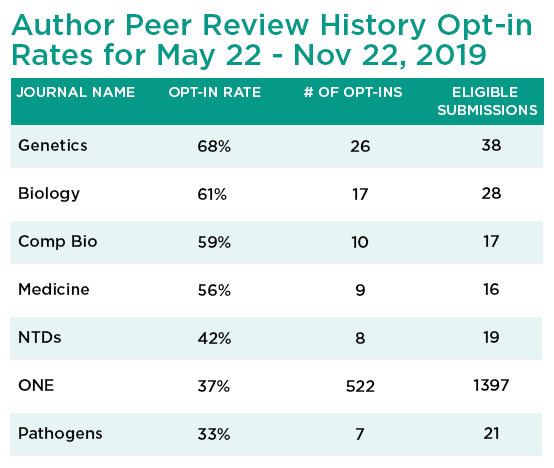We’re pleased to once again annual reporting from the Plan S Price & Service Transparency Framework for 2022…
Celebrating 6 Months of Published Peer Review at PLOS
We recently passed our six-month anniversary of published peer review options at PLOS!!! Already you can read more than 800 PLOS articles accompanied by their complete peer review history — and that number is growing everyday.
To celebrate this huge step towards transparency – and to be transparent about our own findings – we want to share what we’ve learned from this process so far.
Author Response
Between May 22 when we launched this program and November 22, we received 1,536 manuscripts which were eligible for the published peer review history option (authors needed to have submitted their manuscript after May 22 and been accepted for publication). During that time, the average author opt-in rate across all PLOS journals reached 40%.
The wave of support for revealing the expert assessment behind their work has been even higher on PLOS Biology, PLOS Computational Biology, PLOS Genetics, and PLOS Medicine where opt-in rates during the first six months were all above 50% (PLOS Biology is now up to 72%!)
When we look more closely at PLOS ONE–which represents so many diverse disciplines and researcher needs–areas with the highest opt-in rates include Public Health (56%), Neuroscience (40%), Ecology (50%), and Psychology (43%).
My own research is concerned with research metrics and analytics and more specifically the development of a research field… to my knowledge, sharing the entire review history is still relatively rare. I hope more researchers as authors and reviewers will adopt the practice to contribute to the transparency of scholarly communication and open science in general.
Chaomei Chen, PLOS ONE Author, Visualizing a field of research: A methodology of systematic scientometric reviews
This is just the first six months. We’re excited to see what the next year brings as more authors become familiar with the option to publish their reviews, and the community of readers who rely on PLOS find value in more and more expert opinions freely available to read, cite, and share.
Veronique Kiermer, PLOS Publisher and Executive Editor
Has transparent review affected reviewer behavior?
One question posed by our community is how published peer review would impact reviewer activity. Knowing their comments could be made public, would it become more difficult for editors to find reviewers? Would it take longer to return review comments to the authors? So far, we haven’t seen significant changes in either reviewer acceptance of invitations or timing to submit their comments. Of course, our data is still preliminary, and noisy, as many other factors contribute to the reviewer experience, but we expect to learn more as we go.
Ultimately, we hope published peer review will demonstrate benefits to reviewers as well. Making review comments public as a citable object helps elevate the status of reviewer contributions and demystify the assessment process. When reviewers choose to sign their reviews, they can make the review process even more transparent.
Among the PLOS articles which have been published with review history so far, 55% also include 1 or more signed reviews. Combined with tools like ORCID for reviewers, signed and published peer review provides more opportunities for reviewers to publicly receive recognition for their work.
Signed peer review provides a clear avenue for journals to recognise and support their peer reviewers…As peer review is crucial to the integrity of the scientific endeavour, formally crediting peer reviewers and working with research institutions and funding agencies to ensure that time spent on peer review is valued, will ensure researchers are able to devote their time to this important enterprise.
Rhys Grinter, PLOS Genetics Author, Protease-associated import systems are widespread in Gram-negative bacteria
Changing the way we see peer review
We believe true transparency of the research process is the best way to make science more open to researchers and readers of every career stage, demographic and discipline. By opening the peer review process, we can provide more context for research evaluation and educate future generations of researchers.
This publication in PLOS ONE was my first paper that underwent the peer review process, and initially I was unsure on how the peer review process worked… I hope that by publishing our peer review process, we can help demystify the entire process for fellow early career researchers in addition to shedding light on what reviewers may be looking for as they review papers.
Alexandra Muir, PLOS ONE Author, Differentiating electrophysiological indices of internal and external performance monitoring: Relationship with perfectionism and locus of control
To that end, we’re also experimenting with other forms of transparent review by enabling community comments on preprints to be used in the peer review process and streamlining journal agnostic review.
Ultimately, we hope our learnings and the feedback from our community will encourage more researchers and publishers to engage in transparent review, transforming the way we read and evaluate scientific literature. Stay tuned for more updates along the way!

